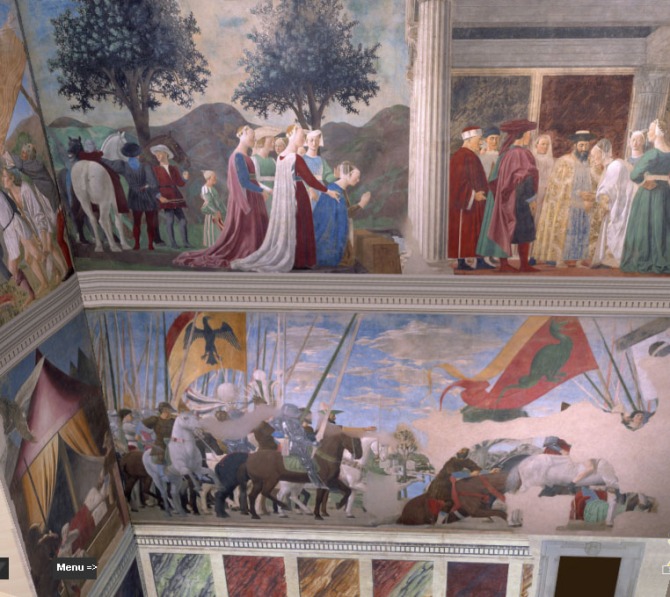There are certain well-known 15th Italian artists whose work you can visit in museums. Then there’s Piero della Francesca (1415 – 1492), who lived and worked in the 15th century. Although some of his work indeed hangs on museum walls (the Uffizi in Florence has his wonderful and famous double portrait of Federico da Montefeltro and his wife) many of his really exquisite frescoes remain more or less where he painted them — that is, in small villages in the Tuscan countryside. The small city Urbino in Le Marche, where he lived for a while under the auspices of the Duke of Montefeltro, is also a rich Piero site, but there I was in Siena. I knew I was close — so close — to some of his greatest works. How to get to them?
It is possible to go some of the way by train – to Arezzo, for example. But for the villages beyond, Monterchi, and Piero’s birthplace Sansepulcro, other transport would be needed. Enter tour guide Francesco and his Mercedes. These towns and villages are within 1 – 2 hours drive of Siena, but including finding and inspecting the art, eating an excellent lunch (omelette with white truffles), and enjoying the countryside, my excursion with Francesco turned into a full day’s outing. Was it worth it, just for a few pictures? Oh, yeah!!
Our first stop was Arezzo, about 1- 1.5 hrs drive from Siena through attractive Tuscan countryside. Arezzo is a prosperous-looking town, with an economy based on gold. Here, we found the Church of San Francesco, a building with a sadly blank and ugly facade (I wonder why?), and inside Piero’s famous fresco cycle “The History of the True Cross”, painted between 1452 and 1466. At the church I was given two very good booklets, including one that explained the stories told in the cycle. This was a boon, since the Cycle is based on the confusing story from the Golden Legend (that wonderful medieval best-seller that augments the Biblical stories with a whole lot of back-story and legend), and the pictures are in no particular order (except perhaps one known to the artist). There has been significant damage to some of the frescoes, which are located in a small nave behind the altar. These days they are carefully preserved and well-lit. The figures are beautiful, with that ethereal beauty that characterises Piero della Francesca, and the illustrations of the stories are very imaginative. I was especially struck with the death of Adam.
‘The History of the True Cross’ is Piero’s largest work, and is generally considered one of his finest. According to this intriguing legend, the cross on which Christ was ultimately crucified (‘the True Cross’) was made from wood which was descended form a tree planted in the Garden of Eden – in fact, the very apple tree that features in the Adam & Eve story (I told you it was imaginative). At Adam’s death, his sons planted a tree from these seeds. There are lot of peregrinations in the story, but the episodes that Piero transforms into his beautiful pictures include the Queen of Sheba recognising a wooden bridge as made from the holy wood, and kneeling before it; Constantine dreaming of the true cross (just before he went into battle as a newly converted Christian – he won, of course); and Saint Helena, Constantine’s mother, going to Jerusalem and extorting news of the whereabouts of the True Cross. It’s an exciting storyline.
‘The Dream of Constantine’ shows him asleep in a rather luxurious tent, his attendants dozing beside him and an angel appearing above. It’s one of the earliest nocturnal scenes in Western art. The cycles is anchored by two large battle scenes (between the Eastern Roman Empire and the Sassanid Empire (from the early 7th century). There’s also an Annunciation, a popular and universal subject.
The faces in Piero della Francesca’s painting are delicate, full of character and psychological insight, and quite fascinating to observe. They are both serene and alive, part of the stories being portrayed. He’s also a master of perspective, geometry and mathematical layouts, very cutting-edge for his day.
Last year the Frick Gallery in New York City gathered a collection of the eight Piero della Francesca paintings extant in America. I was fortunate enough to see it, and it was a very popular exhibition, as much for its rarity as anything else. Critics raved. I can tell, though, that seeing those wonderful small pieces, so carefully preserved and exhibited on the gallery walls, was as nothing compared to seeing his huge fresco cycle in situ in Tuscany, in the very space where the master (and his assistants) painted it almost 600 years ago.
Oh yes, the trip along the Piero della Francesca trail was worth it… to be continued….










Reblogged this on ARTwalkARTtalk.
LikeLike